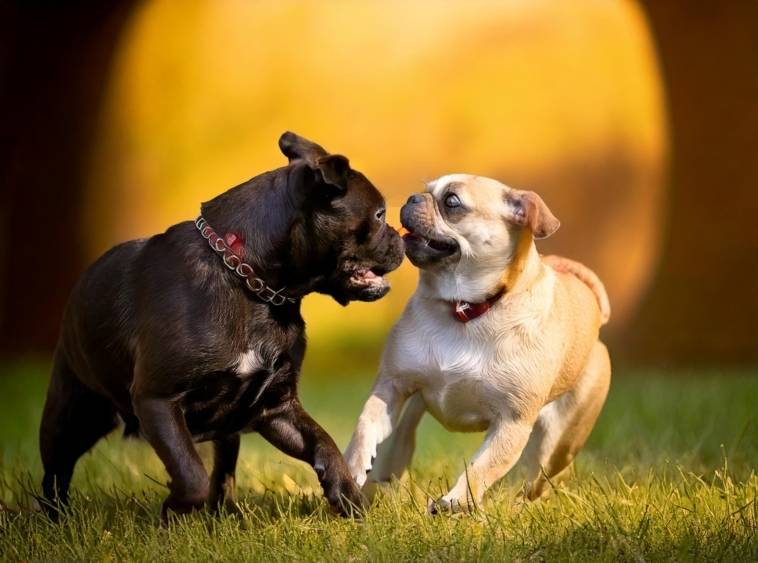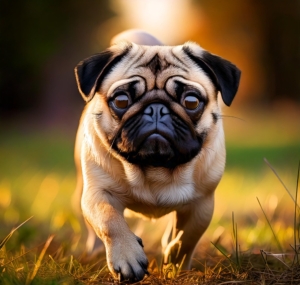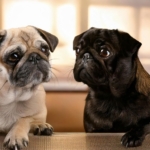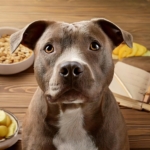Last updated on October 24th, 2024
Here’s an overview;
Introduction: Pugs vs Pitbulls
Compatibility with Families and Other Pets
Addressing Common Prejudices and Constructions
Which Breed Is Right For You? Pug vs Pitbull
Expert Opinions and Real-life Experiences
Introduction: Pugs vs Pitbulls
Pugs
Pugs have become one of the most popular toy breeds. This breed has a unique look characterized by a wrinkled face, a short muzzle, and a curled tail. They are friendly, affectionate, and make excellent companions.
Key Characteristics:
- Weight: 14-18 lbs
- Height: 10-13 inches
- Lifespan: 12-15 years
- Temperament: Playful, loyal, charming
Pitbulls
Pitbulls is a term that has come to be used generically to refer to the American Pitbull Terrier. They are great looking dogs that exude strength, muscular build and are highly intelligent.
Key Characteristics:
- Weight: 30-60 lbs
- Height: 17-21 inches
- Lifespan: 12-16 years
- Temperament: Confident, courageous, affectionate
History and Origins
The pug, which has a the natively wrinkly-face, is tiny in size, is believed to have originated from china. Such dogs were bred as companions for the Chinese imperial family and hence were often seen in the palaces. Later, they spread to Europe where they captured the love of noble houses.
Pitbull is a generalized term given to several dogs, that can be traced back to the early 19th century in England which is also believed to be the center of breeding Old English bulldogs that were used for bull-baiting, and later on, made their way to America where they served as multi-purpose farm dogs, Their attributes changed along with human views which shaped to strength, loyalty and agility.
Physical Characteristics
Pugs:
- Size: Small, weighing usually between 14 and 18 pounds, measuring between 10 and 12 inches in height.
- Body: Dense, blocky, and muscular.
- Head: Big, round head completely covered in folds and wrinkles.
- Eyes: Large, round in shape, dark color.
- Ears: Lie flat against the head, rose or bat ears in shape.
- Muzzle: Small, broad, flat, and short.
- Tail: Overall tail very tightly curled over the hip.
- Coat: Coat is fine and smooth, and hair comprehensively short polished. Other colors include fawn, silver or apricot black.
Pitbulls:
- Size: Medium, anywhere from 30 – 85 lbs, standard height ranging from 17 to 21 inches.
- Body: Stocky, powerfully built, and quite symmetrical.
- Head: A broad, wedge-shaped head with strong muscle cheekbones.
- Eyes: Medium oval shape and medium size, slanted.
- Ears: Ears can be docked or natural standing ears, set high.
- Muzzle: Square and thick, wide and deep with a moderate length.
- Tail: Tapered tail that gets skinnier at the end but thick at the base.
- Coat: A short-coated stiff and shiny hair coat. Comes in various colors in an assortment of styles.
Temperament and Behavior
Pugs and Pitbulls exhibit different temperamental characteristics.
Pugs:
- Friendly and cuddly
- Likes to be around people
- Active but somewhat stubborn
- Often forms close attachments with owners
- Usually gets along with other animals
Pitbulls:
- Faithful and protective
- Very energetic and powerful
- Needs socialization and training
- Can be very affectionate
- Can be territorial
For the most part, comprehending the temperament of every particular breed allows owners to address the individual needs of their pets. Correctly conducted training and socialization have a significant impact on behavior.
Exercise and Energy Levels
Distinct exercise challenges and energy demands are presented by both Pugs and Pitbulls.
Pugs:
- Need only moderate exercise.
- Prefer a short walk and some playing indoors.
- Can suffer from heat exhaustion since they are brachycephalic.
Pitbulls:
- Need intense exercise.
- Enjoy running, performing agile exercises, and playing fetch.
- Need some stimulation to keep them from being bored.
Both breeds require some form of physical activity but the levels and time required for the activity are quite different. Owners have to adjust the exercises accordingly in order to promote good physical fitness and avoid bad behavior.
Health and Lifespan
There are noticeable differences between Pugs and Pitbulls, especially with health requirements and average lifespan.
Pugs:
Common Health Problems:
- Brachycephalic airway syndrome
- Hip dysplasia
- Eye conditions (corneal ulcers).
Lifespan:
- 12 – 15 years.
Pugs need to go to the vet a lot so that the vet can keep track of their breathing and check their eyes.
Pitbulls:
- Common Health Problems:
- Hip dysplasia.
- Allergies (skin conditions).
- Heart disease.
- Lifespan 12 – 16 years.
Regular exercise and a balanced diet can help improve pitbulls’ health. Both breeds require regular medical attention as well if they are to lead a good life.
Grooming and Maintenance
Pug grooming and maintenance will vary from Pitbull.
- Regular brushing done on a short coat of cut hair
- Regular cleaning done on facial folds to avoid possible infections.
- This breed is known to shed hair from time to time hence vacuuming is advisable.
- Only one bath is allowed in a month.
- Use nail clippers and trim every two weeks.
This breed requires less attention from time to time cut during periods, Long and shiny coat of this breed, use only once every 2-3 months, only use around trims every 3 weeks or so, ears forcibly squeaky clean to prevent irritation.
Both breeds need to perform oral hygiene regularly to prevent the risk of developing periodontal diseases. regular vet visits are very important to prevent health risks.
Training and Socialization
This will be the best way to compare Pugs to Pitbulls and why they need different training for them.
Pugs:
Only the gentle encouragement works when training Pugs as they easily become stubborn.
- Short and engaging sessions are recommended, and negative commands should be abolished.
- Pugs’ socialization at a young age renders them good as adults.
Pitbulls:
- Pitbulls respond well when they are trained through consistency with a firm approach although there should be a positive training approach employed.
- Early socialization is very important to avoid aggressive behavioral problems.
- Important as well, are mental activities, such as puzzle toys.
Both Pugs and Pitbulls can effectively adapt to a da ily routine and appreciate the consistency that comes with training. For both type, obedience classes are useful as they improve their behavior and socialization aspects. Likewise, any exposure to different environments, people, and pets early enough will make sure that both types grow up to be disciplined pets.
Compatibility with Families and Other Pets
The level of Pugs and Pitbulls compatibility varies with families, and other pets.
Pugs:
- Due to their affectionate and friendly character, family environments suit them well.
- Because of their calm temperament, Pugs are normally very good with children.
- Additional pets are usually accepted, especially if introduced while the Pug is young.
Pitbulls:
- Pitbulls are frequently loyal and protective family members, making them ideal family pets.
- Supervision is critical as energy levels may be high for children under the age of five.
- They need to be socialized properly to live in harmony with other animals.
Both types do need time, training, and socialization in order to ensure that there will be harmonious interactions within the family as well as with other pets.
Diet and Nutrition
Diet does differ quite a bit: Pugs and Pitbulls should have different dietary plans because they have different sizes, activity levels, and health requirements.
Pitbulls:
- High-protein diet is mandatory to maintain muscle mass.
- Massive and muscular dogs have a higher energy intake.
- Regular check-up is necessary to prevent obesity.
Pugs:
- Balanced diet is a must to control weight.
- Over weight and should prevent injections of food.
- Less in size makes calories expense lower.
Both breeds benefit from:
- Fresh water always within reach.
- Veterinarian-approved food that is appropriate for dogs.
- Regular feeding times for good dog health in general.
- Veterinary consultations for individualized diet plans.
Cost of Ownership
There is a huge difference in the cost in taking care of a Pug or a Pitbull.
- Initial Purchase Price: The price of a Pug goes between $800 and $1500 while Pitbulls go for between $500 and $2000.
- Grooming: A pug’s grooming must be done regularly and it comes at a charge of $30 to about $90 monthly. On the other side, Pitbulls that have short coats get grooming at a low rate of $25 to $50 monthly.
- Food: One can spend over $30 to $50 a month for Pugs and $40 to $60 for a Pitbull.
- Healthcare: Pug and Pitbull have the same amount of care as the Pug in yearly veterinary costs such checkups, inoculations, and unforeseen medical problems that go at $500 to $1000 annually.
Addressing Common Prejudices and Constructions
Prejudices and Misunderstanding towards Pugs
- Size and Energy Requirements: Some people have the misconception that pugs are calm because their bodies are small, but they can also showcase “spurts” of energy.
- Smoking and Over weight Dogs: Breathing problems like some of the other pugs are not cut across. These issues can be controlled with good care and frequent vet visits.
Prejudices and Misunderstanding toward Pitbulls
- Dangerous Nature: This stereotype is quite the opposite for most until poodles are known to be aggressive dogs. This is not entirely true.
- Family notably with children: For families, this dog is said to be bad and not suitable. In fact, they are very loving and caring dogs that can take care of the family.
Which Breed Is Right For You? Pug vs Pitbull
For people trying to decide between a Pug and a Pitbull, there are a few things to consider:
- How Active an Owner is: Pugs are a bit higher than moderate exercise so a sedentary owner is sufficient. Quite the opposite goes for people when it comes to pitbulls.
- Space: The pug will be alright in an apartment as they can adjust, but pit bulls will need a large area preferably with land.
- Medical / Health Issues: Pugs have a risk of suffering from respiratory problems. Pitbulls may have hip dysplasia and may also suffer from quite a lot of skin allergies.
- Temperament: A pug is a gentle dog but can also be quite the stubborn breed.
- Grooming Needs: Pugs tend to have higher grooming needs. On the other hand, Pitbulls are easier to maintain.
Expert Opinions and Real-life Experiences
Both dog trainers and veterinarians have the opportunity to present their views on these two breeds.
Veterinarians:
- Provide insight on the tendency of Pugs to have difficulty in breathing.
- Cite a need to feed Pitbulls more regularly and exercise their muscles more often.
Dog Trainers:
- State that Pugs can be quite obstinate but are amenable to consistency.
- Pitbulls are appreciated for their willingness to go through training and their motivation to satisfy their owners.
There are also dog owners who share their insights as well. A portion of a pug owner’s experience:
“Being a Pug owner involves understanding what it means to love a pug – many hours of care plus an ample about of couch time with the pug”
Conclusion: Pug vs Pitbull
Even if the arena of the Pug and Pitbull dogs seems sculpted from two totally different worlds, they both have their own features that can be advantageous to prospective pet owners:
Pug Characteristics:
- Compact structure
- Conformable for indoor purposes
- Moderate level of activity is enough
- Gentle and delicate pets, love and bless their owners.
Pitbull Characteristics:
- Strong and muscular medium sized physique
- More demanding in terms of exercise
- Features persistence and aggression and had trouble in trusting individuals.
Understanding these facts about Pugs vs Pitbull breeds enables the prospective owners to anticipate their pets, which would most better recommend to their home, family and lifestyle.





